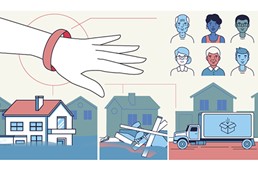Superfund Research Program
December 2022
 Anderson discussed how her team used their silicone wristbands to measure exposures after Hurricane Harvey hit Houston. (Image courtesy of Kim Anderson)
Anderson discussed how her team used their silicone wristbands to measure exposures after Hurricane Harvey hit Houston. (Image courtesy of Kim Anderson)During the last two sessions of the three-part SRP Climate Change and Health webinar series. researchers discussed how climate change can potentially increase exposures to health hazards, as well as what they are doing to tackle this complex challenge. Topics covered include harzadous exposures related to hurricanes, wildfires, and melting permafrost.
“Extreme weather events, such as hurricanes, extreme heat, wildfires, storms, and floods, are increasing in number every year, becoming more extreme, lasting longer, and having bigger impacts on communities in the U.S. and around the world,” said Gwen Collman, Ph.D., the director of the Office of Scientific Coordination, Planning, and Evaluation at NIEHS.
Throughout the two sessions speakers, including Naresh Kumar, Ph.D., of the University of Miami, Deborah Watkins, Ph.D., of the Northeastern SRP Center, and former SRP trainee Elena Craft, Ph.D., spoke about contaminant redistribution after hurricanes.
Other speakers include Julia Rager, Ph.D., of the University of North Carolina at Chapel Hill SRP Center, Elsie Sunderland, Ph.D., of the University of Rhode Island SRP Center, and Kim Anderson, Ph.D. of the Oregon State University SRP Center.
Read more in the NIEHS Environmental factor newsletter.


